If you are looking for maximum redundancy
Dave Apperley
Imagine being 20 minutes into a dive, 120 meters deep, in a cave, and having your breathing system fail! Not only do you need to breathe NOW, you also need to be able to breathe for the next three hours while you do your in-water decompression stops. The diver needs to allow for a second breathing system in case the primary system fails. Among rebreather divers there are two schools of thought. One option, and the one that is usually taken, is to either carry extra open circuit cylinders or stage them within the cave. The other option is to wear a second rebreather throughout the dive. If the main rebreather fails, the diver can switch over to the second unit and abort the dive, knowing their gas supplies are still at an optimal mix with a very long duration. Dave Apperley has chosen this second method for his bailout scenarios.
I wish to thank him for his permission to publish this article.
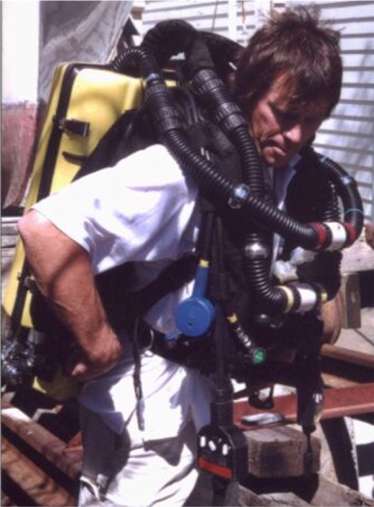
Dave has taken a standard Buddy Inspiration rebreather, stripped the guts out, and repackaged it into a custom case along with a complete second loop. The second loop uses standard Inspiration counterlungs, hoses, and mouthpiece, but utilises a custom built scrubber made from PVC. In this photo you can see the two sets of breathing hoses and mouthpieces, and the two sets of counterlungs. Dave is shown adding oxygen to the second system. There is one set of electronics in each unit, and are identified by coloured markings. The red electronics corresponds to the red mouthpiece, and likewise the yellow electronics and mouthpiece.
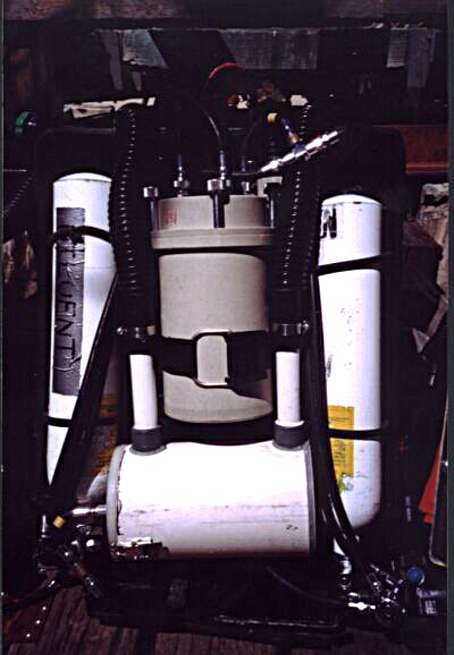
Here is the unit with the rear cover removed. As you can see, the original Inspiration scrubber is upright, slightly higher than the normal position, and the second scrubber is horizontal below it. Flexible rubber hoses connect the second scrubber to the counterlung T-pieces. The internal tanks are the normal three litre steels for the primary loop, and Dave wears side slung tanks for the second loop.
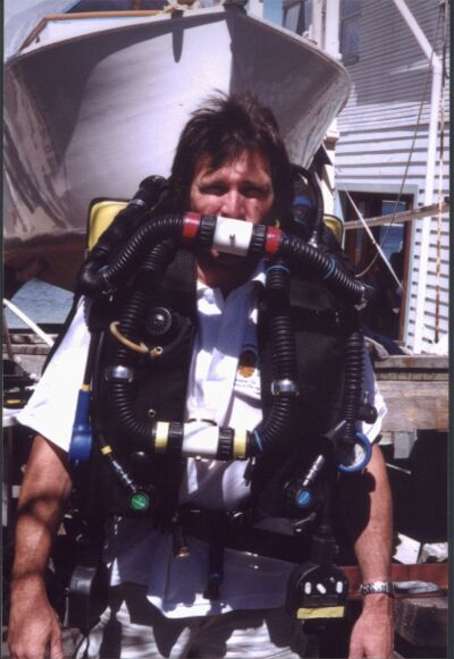
In this front view you can see that the unit is reasonably uncluttered, not really much different to the standard Inspiration with the counterlungs over the shoulders. Of course the two side slung cylinders for the second unit are still to be connected, but most Inspiration divers carry at least one of these anyway. The only giveaway in this shot is the second set of hoses and mouthpiece.
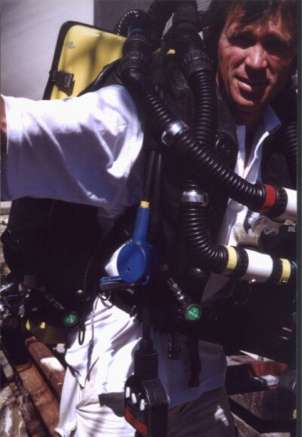
And here is what makes this setup so neat. The second set of counterlungs are mounted between the casing and Daves back. In this position they are very unobtrusive. You can plainly see the two green oxygen addition buttons, one for each loop.

The case was custom built by Rebreather List member Bruce Stewart. It is based on the original housing, but has more internal volume. It was originally made to house a single Inspiration fitted with Faber seven litre steel cylinders so there is still a fair bit of internal space not used.

A line up of rigs after a recent 50m wreck dive off Sydney. On the left is Jason’s Mk15, next is Dave’s twin Inspiration, and on the right is Barry’s standard Inspiration. There was also another standard Inspiration on this dive. Note the hinged casing on Barry’s unit.
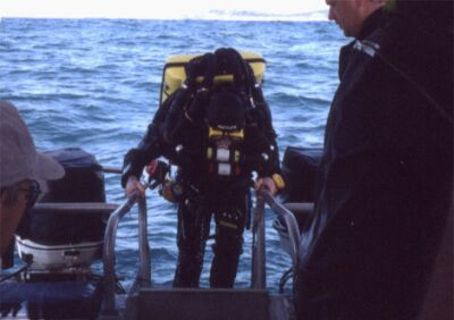
Dave climbs back onto the boat after the afore mentioned wreck dive. The unit weighs 46 kilograms so it’s not too much trouble to climb the ladder.
This second story on the Twinspiration was sent to me by Philippe Couvreux France. He built a very special double CCR. In his story he explains why he decided to built this unit. A very interesting adventure

Hello Janwillem,
Here are few lines about my Twinspiration story. The adventure begins about 2 years ago when I started to become frustrated because I had to stop my deep dives because of bailout considerations. I had one machine on my back that allowed me to stay 4 hours down and my bailouts divided that time at least by two and reduced my maximum depth to about 120m. Because I did not want to bring with me more than two sling tanks, the only solution was to have a second CCR as bailout.
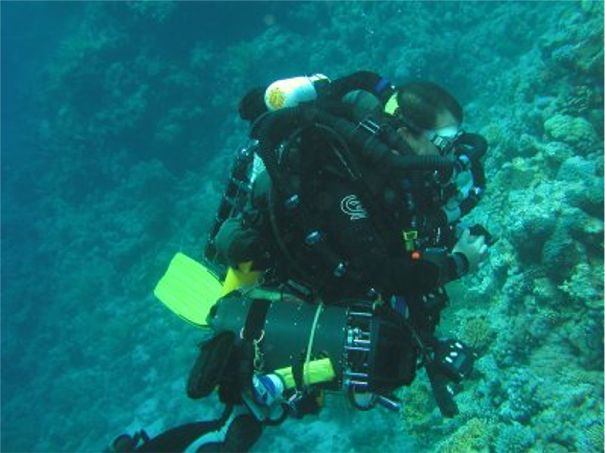
Specifications:
This where the outlines of my design:
– The bailout CCR will have to be full automatic (automatically inflated and deflated).
– The automatic inflating device of the bailout CCR could be stopped at any time by the diver.
– The redundancy will have to be full (2 complete CCR)
– All the tanks should be used by both CCR (swapping O2 admission for one CCR to the other and swapping diluent admission for one CCR to the other).
– Changing of diluent (ie: tmx to air) will have to be possible on both CCRs.
– Emergency procedures (closing O2 tank, purge…) will have to be done easily as for a single Inspiration.
– Both CCR of the Twinspiration should be used at the same time (no interferences between the CCRs).
– The diver will not need any help to be equipped or unequipped.
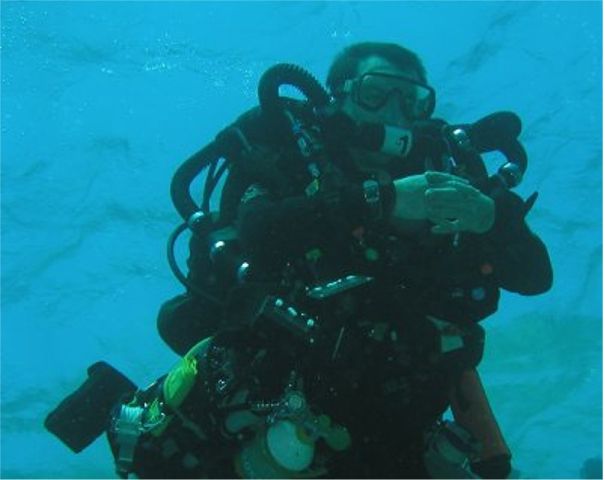
Due to economical and maintenance reasons an important point was also that the Twinspiration will have to made with standard parts. The Twin-counterlung: According to those specifications, I decided to create a specific twin-counterlung. That was the only solution I saw. The counterlungs should be side by side to prevent any interference between them and to be easily deployed. At that time, gas swapping or diluent changing procedures were solved. More, that way gave to me the solution of another problem: weights. Due to the second breathing loop the machine will be too much positive. Although I reduced the width of the original single lung to be able to put two lungs side by side, the width was still big enough to add weight pockets on the counterlungs. The space between the two T pieces was big enough to channel the BCD hose and at least five standard hoses.
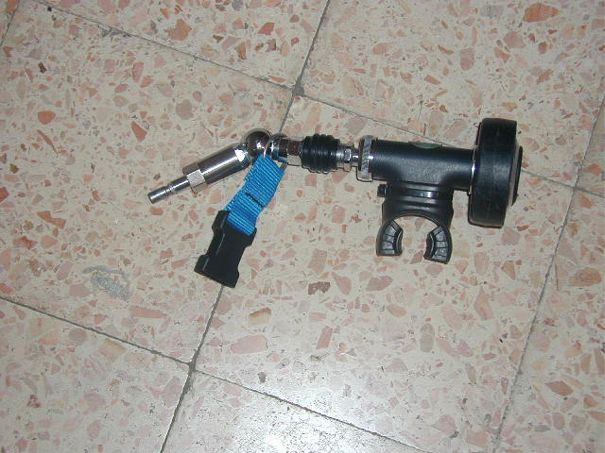
The automatic inflator: I decided to create the automatic inflator around an Apeks TX40 second stage for the good reason that most of my regulators are some. Its location at the place of the Inspiration manual inflator was imposed by the fact that I wanted to be able to swap diluent admissions. I mechanically strengthened the original Apeks membrane due to the air column generated by the length of the lung, added a free flow control device to stop the diluent flow if needed and machined an adapter to connect the original Inspiration manual inflator quick connector to a standard inlet of second stage. The automatic inflator is connected to the counterlung as a standard manual inflator. In this way if any problem occurs with it before a dive, it can be replaced easily by a manual inflator…or by another automatic inflator! After tests it appeared quickly that to adjust the flow of diluent, a TX40 was not enough, that is the reason why I added the missing parts of a TX50.

The automatic deflating device: The automatic deflating device was made by changing the manual over pressure valve of the lung by a dump valve. For what I heard after some other Inspiration’s divers already did it with success.
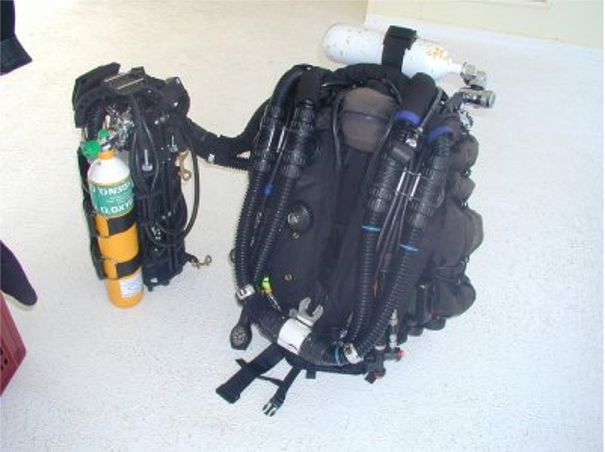
The tanks holder: The side mounting choice of my second Inspiration was decided by two facts. Firstly I did not want to change so much my original Inspiration. Secondly I was sure to not need every day a Twinspiration and I did not want to have two machines to carry, one Inspiration and one Twinspiration. So I planed only to add outboard tanks to my Inspiration, as many Inspiration’s divers do, and to carry the second unit as a sling tank protected by a “quick made” case. After a while, I realized that few elements were missing to have a complete second Inspiration. I would like to built a housing for my side mounted Inspiration with a double function. I modified my plans to be able to use the case as a tank holder on my back. For the fun I decided to create a tank holder than could support up to five tanks, including two height liters tanks for the diluent and one 6 liters for the BCD and the dry suit. By that way I will have a Twinspiration that should be able to go up to -200m as safe as it could be. According to that last modification I was on the way to have two complete Inspirations, that fit together, thanks to a small kit, should make a Twinspiration.
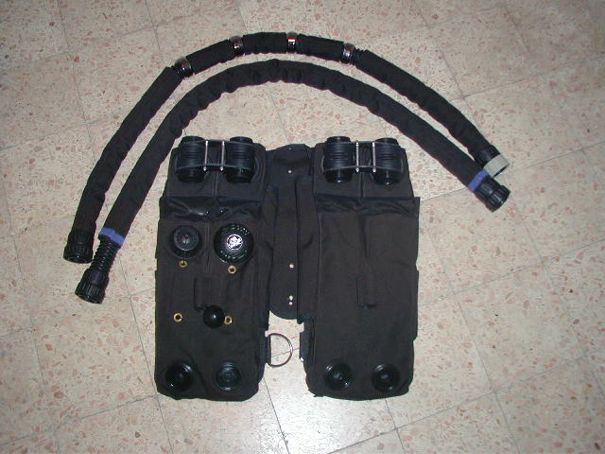
I completed my drawings to have a tank holder where a tek diver could fix all he wanted. Finally a place was reserved for advertising, logos or whatever. Another good point to create a tank holder was to try to reduce the weight of a single unit when traveling. Thanks to that tank holder, I can fix now most of the dive tank I find in diving centers.
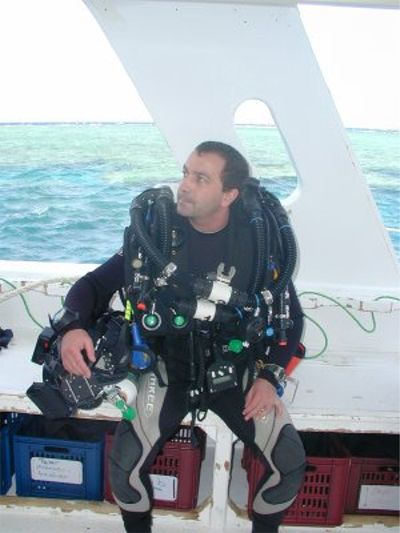
The removable second stage: What about second stages? Even with a Twinspiration I saw cases when taking few breath from a second stage could be useful, especially at depth. That is the reason why I still have second stages connected to my diluent tanks. There are located both on my back and don’t disturb me at all during the dive. One of my pleasures is to finish the last 6m of a deep dive on open circuit on oxygen. Because of full redundancy considerations (I am a bit paranoiac), I would like to be able to breathe oxygen from both tanks but I did not want to have a big amount of second stages. That is the reason why I made a removable second stage. I used the same kind of adaptor I used for my automatic inflator, connected a 360 degrees flexible elbow for practical reasons and a free flow control device to prevent loss of oxygen and it was done. Results in the water: First job was to code everything to be able to know which equipement was connecting to which.
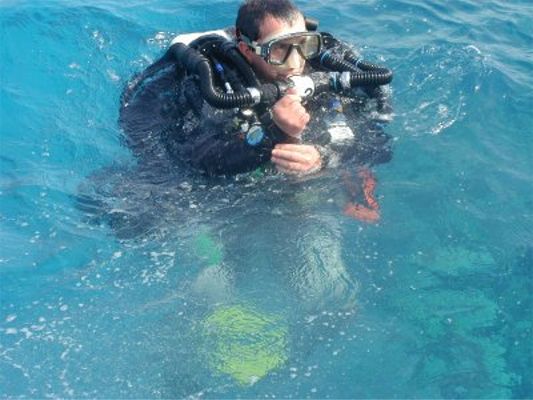
My two mouth pieces are different to be able to identify them only with the tongue, all my hoses concerning my bailout loop are identified with little plastic rings and the ones concerning my main loop have bigger rings (the rings are yellow for oxygen and blue for diluent), the handsets are numbered and each pair is far away from the other one…
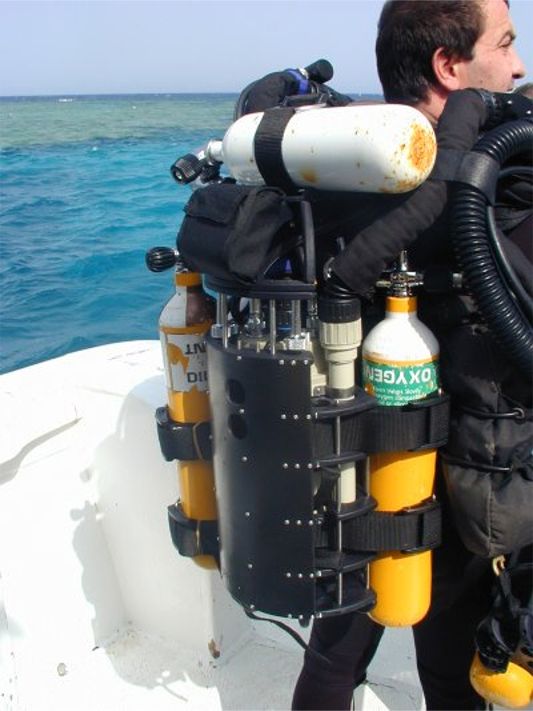
Diving with two Inspirations is not exactly the same as diving with one. Many shallow dives have been made to define new procedures. As example, both loops cannot run with the same PPO2 set point during the dive. When the procedures are assimilated and if there is no need to go to the bailout loop then you really think that you have only one single Inspiration on your back.
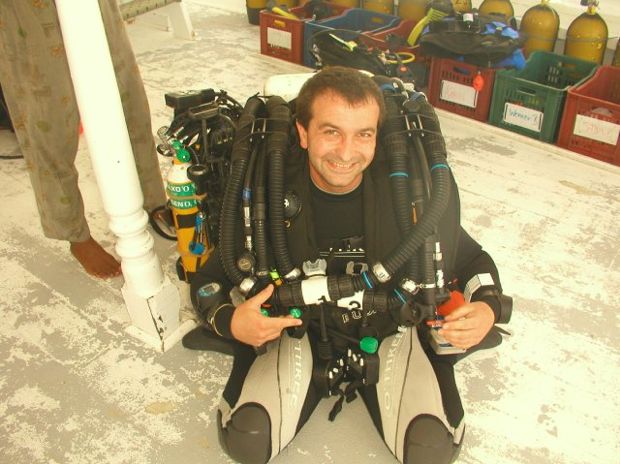
Thanks to my Twinspiration I was able to go deeper, and in my point of view safer. I was also able to dive on heliox, one thing that I have been dreaming from a long time.
About the future: The only thing I would like to make now to finalize my project is a small kit in order to carry both Inspirations on my back. I do not think it will be complicated to do but I am a bit afraid about the huge back pack it will make. The actual side mounting allows me penetrations by putting the sling unit in front of me. I will have also to make few modifications because that Twinspiration is a first try and everything is not 100% perfect…but fortunately almost!
Janwillem;
What a long time we have spoke! I hope that everything is going OK for you. I hereby sent you the latest Twinspiration improvement. As I said a couple of year ago, my plan was to create a kit to fix both CCR’s on my back, so here it is. Unfortunately I’m not able to send to you underwater photos with the final version of that Twin yet. Anyway, my last version is only a bit “cleaner” but it looks like the one on the photos. The swimming pool tests gave really good results. Stability and buoyancy is OK. To compare the single setting and the twin one, I put also 2 photos of my Inspiration in the single configuration. And what about you? Did you enjoy your Trimix dives in France last year. Bye, Philippe Couvreux
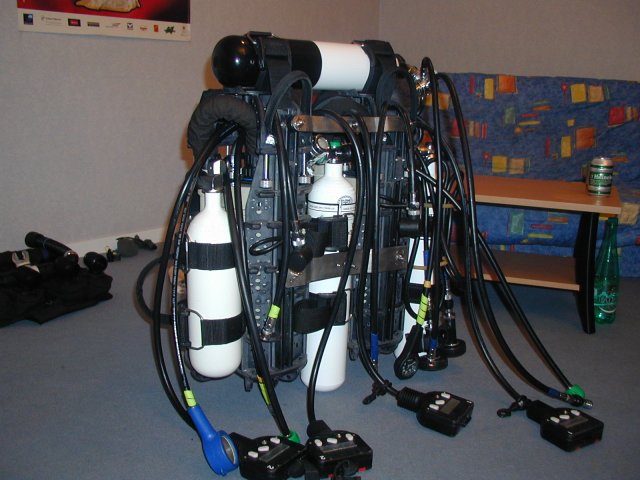
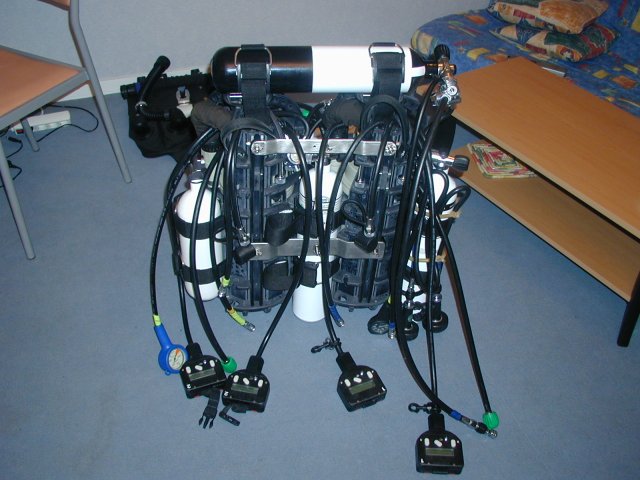
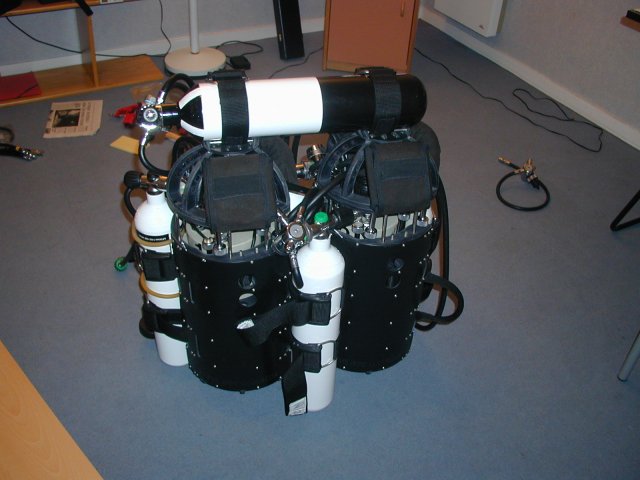

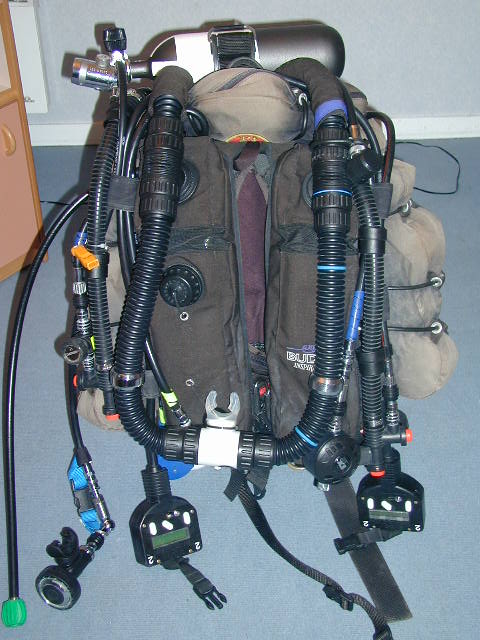
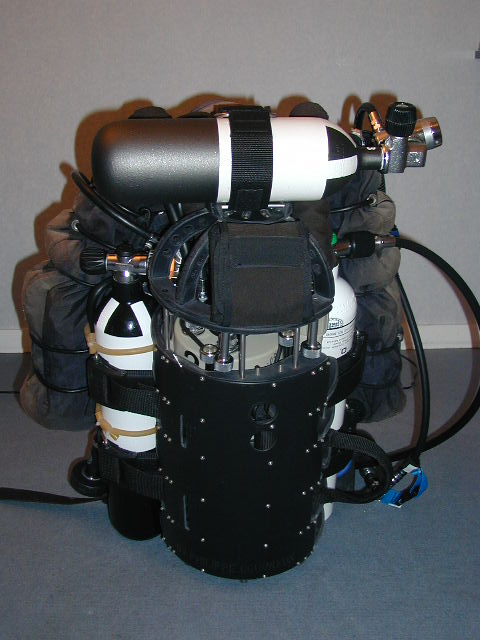
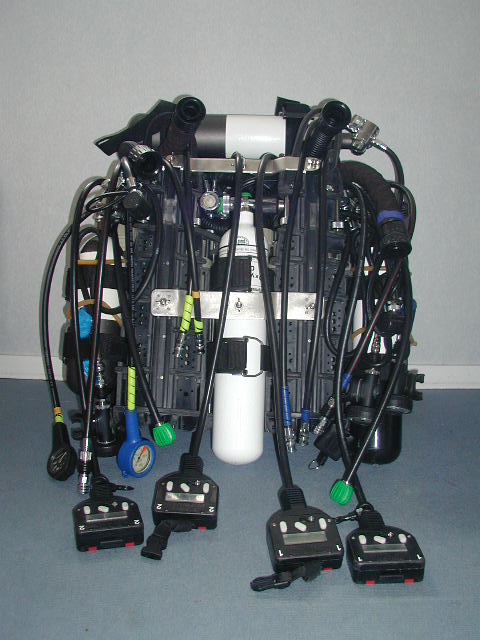
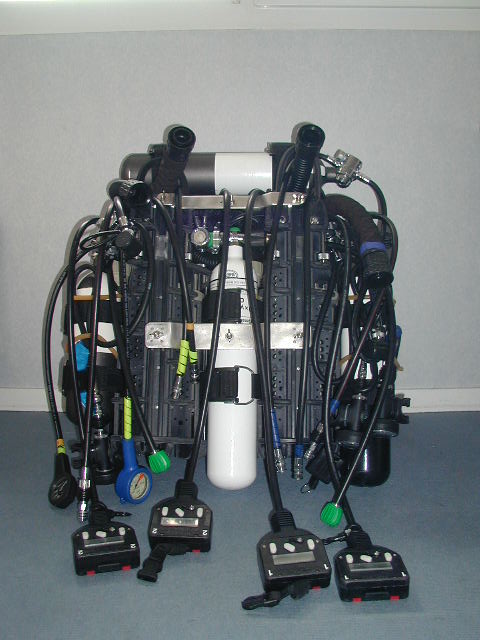
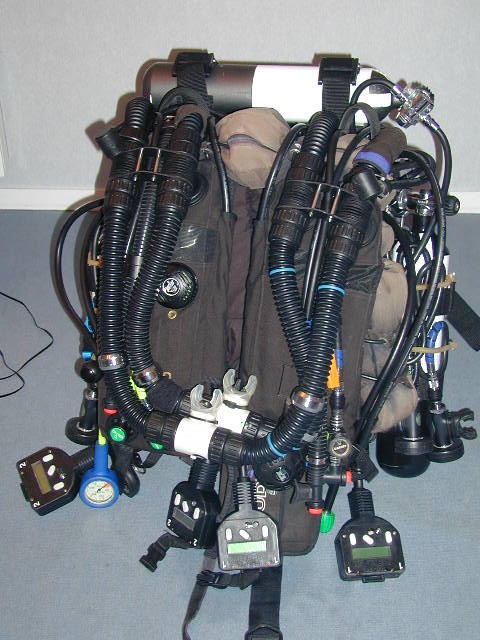

Well, here is third Twinspiration story. This one is sent by Dave Thompson. He is making a study on how to built a reliable Twinspiration with smart and simple design. The pictures are not his definite design, but just a study and tryout model. Later there will be lots of modifications but we will follow the progress….
Take CARE:
This Twinspiration, its worth it to say I would not dive with just one handset, the vr3 is back-up on the primary loop. As yet the second loop has no electronics. swimming pool testing was done by running the second loop as an o2 rb. Therefore this rig is not ready to dive with and is just an experimental model!
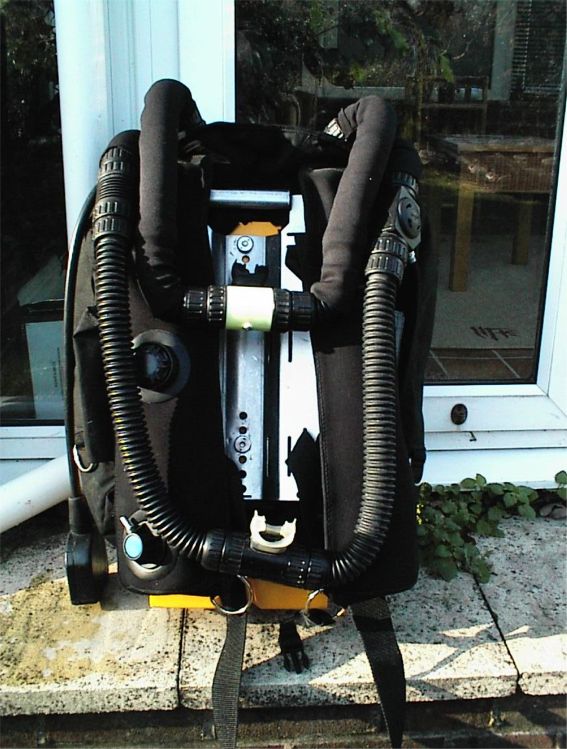
OK, what do we see:
- Back plate style mounting
- Bob’s ADV
- Modified overpressure valve on exhale lung
- Quick release counterlungs
- Two mouthpieces
- One handset
- Two different colored mouthpieces
- 1 Short and 1 longer loop
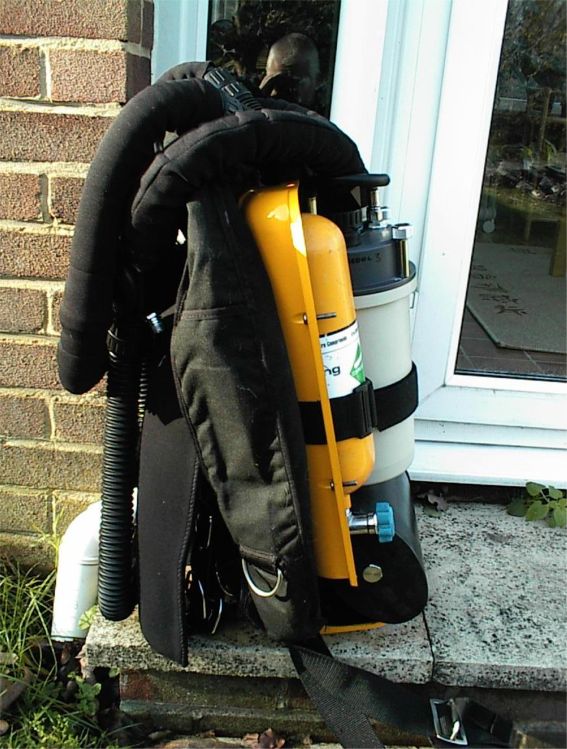
And what do we see here:
- 2 liter cylinders
- Modified scrubber lid
- Dolphin scrubber!
- Wing rebuilt with counterlungs inside
- 2 Sets of T-pieces, one front (original location) and one set on the modified wing.
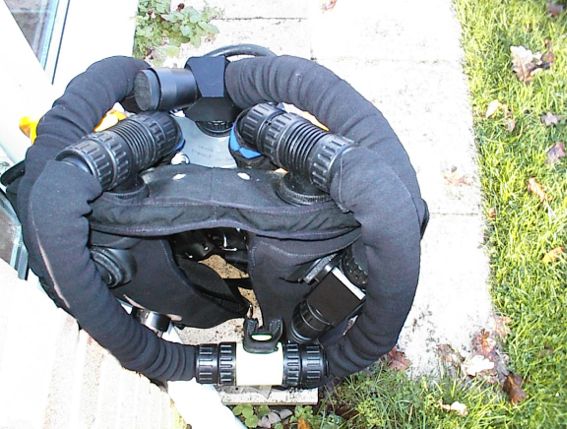
Here we have a better view on what Dave did. He filled his wing with two counterlungs and mounted two T-pieces. The second pair of hoses are located behind the original scrubber in the direction of the Dolphin scrubber. On the top of the modified lid you see Bob’s fourth cell holder, a possible link to a VR3 or other measuring device. In case of the newer hammerhead lid it could even be equipped with 5 cells, 4 in the lid and one extra cell in the external holder.
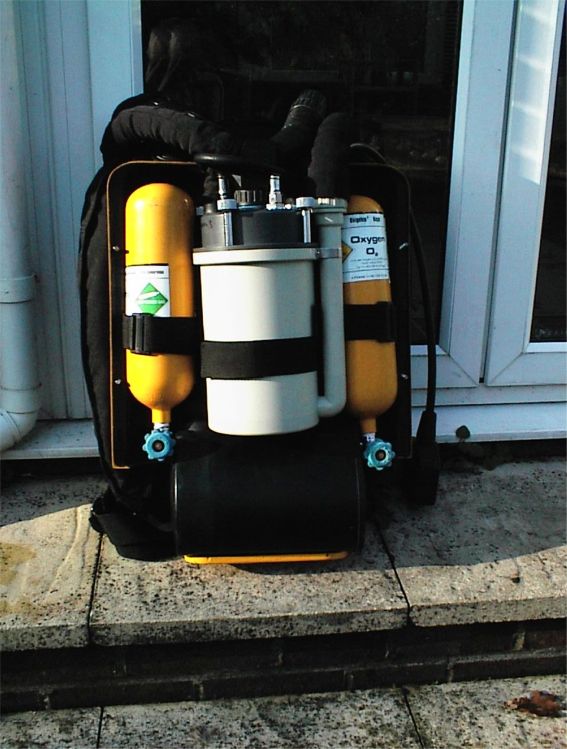
Here we can see how the interior was built. Because shorter two liter bottles were used, there was space created for the second scrubber. Dave told me that in a later stadium the box would be exchanged for the 7 liters box, and then 5 liter bottles are going to be used. In this way a incredible compact design is realized!
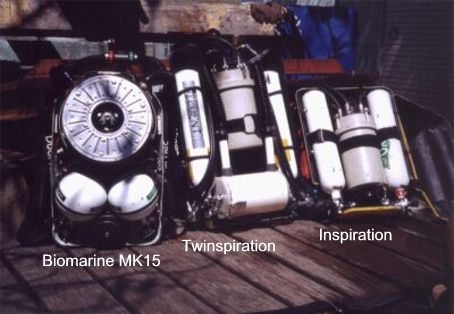
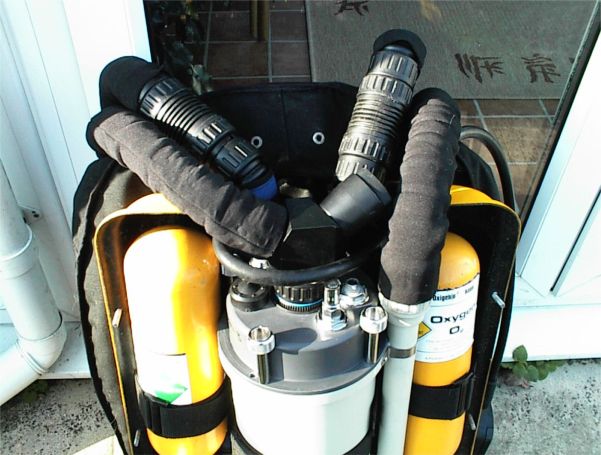
It has to be said that the rig looks very cool. Although Dave is in the progress of this design, he would only use it when completed. Things who are still to change are: Bigger housing for 2 x 5 liter cylinders. Hammerhead lid for the primary Rebreather, and original Inspiration lid for the redundant rebreather. Extra connection to VR3 for real time decompression.
Dave thanks for contributing another Inspiration to my web 😉

Therebreathersite was founded by Jan Willem Bech in 1999. After a diving career of many years, he decided to start technical diving in 1999. He immediately noticed that at that time there was almost no website that contained the history of closed breathing systems. The start for the website led to a huge collection that offered about 1,300 pages of information until 2019. In 2019, a fresh start was made with the website now freely available online for everyone. Therebreathersite is a source of information for divers, researchers, technicians and students. I hope you enjoy browsing the content!
